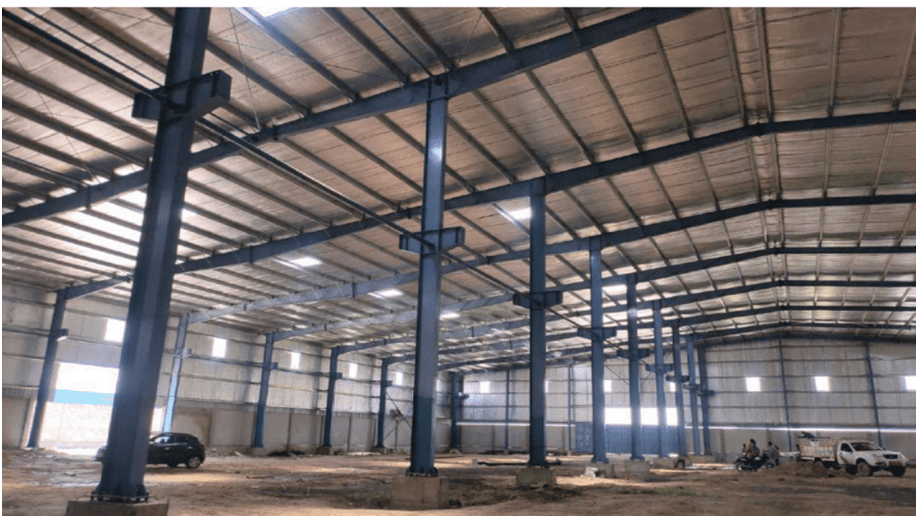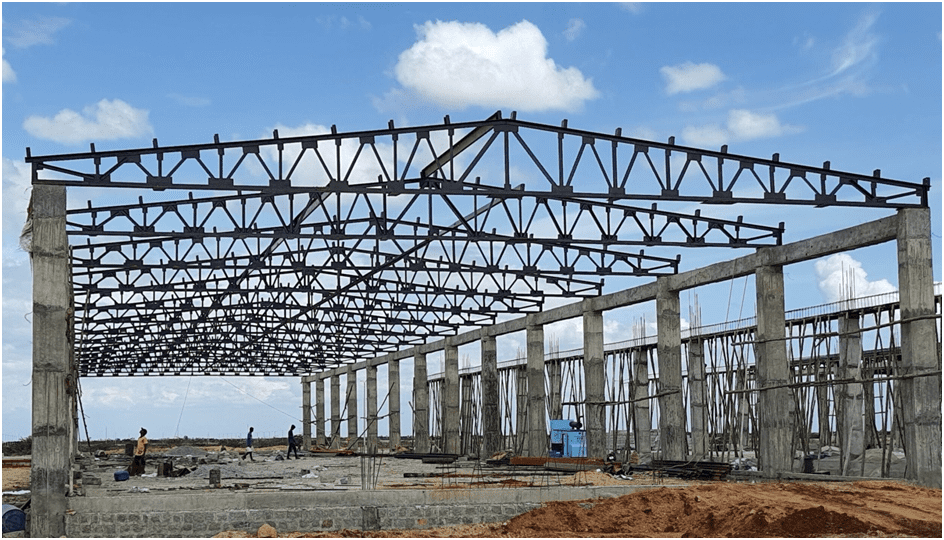Pre-engineering building vs. traditional construction: which is right for you?
In the world of construction, there's an on-going debate about the best approach to building structures. Traditional construction methods have been around for centuries, but in recent years, Pre-Engineering Buildings (PEBs) have emerged as a popular alternative.
In deciding between Pre-Engineering Building and Traditional Construction, it's crucial to assess your project requirements, budget constraints, and desired outcomes. PEB offers efficiency and cost savings, particularly for large-span structures, while traditional construction provides more design freedom and aesthetic appeal. Ultimately, the choice depends on the specific needs and priorities of your project.
What are PEBs?
Pre-Engineering Buildings are structures that are designed, fabricated, and assembled using prefabricated components, such as columns, beams, and roof trusses, before being transported to the construction site for final assembly. The process involves meticulous planning and engineering, resulting in a faster and more efficient construction process compared to traditional methods.
One of the distinctive features of PEBs is that the manufacturing company shoulders the entire burden of production, from raw materials to labour, ensuring a hassle-free experience for consumers. This innovative approach not only simplifies the construction process but also eliminates additional burdens traditionally placed on the end-users.
Imagine building a structure like putting together a giant puzzle. Traditional construction is like building the puzzle one piece at a time on-site, while Pre-Engineering Buildings (PEBs) are like bringing the puzzle pieces ready-made, and assembling them quickly. This innovative approach saves time and effort, making it an attractive option for various construction projects.
Pre engineering building vs. Traditional building
The choice between pre-engineered building and traditional construction methods hinges on factors such as cost efficiency, construction time, structural integrity and sustainability considerations. both approaches offer unique benefits and the decision should be based on the specific needs and priorities of each building project.
In this article, we will be comparing pre-engineered buildings with traditional construction methods.
Let’s look at the benefits of both methods
Pre engineering building vs. Traditional building
The choice between pre-engineered building and traditional construction methods hinges on factors such as cost efficiency, construction time, structural integrity and sustainability considerations. both approaches offer unique benefits and the decision should be based on the specific needs and priorities of each building project.
In this article, we will be comparing pre-engineered buildings with traditional construction methods.
Let’s look at the benefits of both methods
1. Future expansion of building
PEBs
Pre-engineered buildings are renowned for their flexibility and scalability, making them an attractive option for those anticipating future expansion. Here's how PEBs cater to the needs of growing businesses and evolving spaces.

The image provided is a representation of the Royal Import and Export project by Mahawar Group for reference purposes.
PEBs are characterized by their modular design, allowing for easy expansion without disrupting the existing structure. The primary components, such as columns, beams, and panels, are fabricated off-site and assembled on-site, facilitating swift modifications.
The modular nature of PEBs often translates into cost savings during expansions. With pre-fabricated components readily available, the overall construction process is streamlined, resulting in reduced labour costs and quicker project turnaround.
Traditional Construction
Traditional construction relies on load-bearing walls and other integral structural components. Expanding such buildings may require intricate planning to ensure the existing structure can support the additional load, potentially leading to more extensive renovations.
Unlike the swift assembly of pre-engineered buildings, traditional construction projects often have longer timelines. Future expansions may involve more complex processes, leading to extended periods of construction, disrupting regular business operations.

The labour-intensive nature of traditional construction can result in higher overall costs for expansions. Customizing existing structures may require skilled labour and intricate construction methods, contributing to increased expenses.
2. Erection simplicity
Pre-Engineering Buildings (PEBs):
Pre-Engineering Buildings, often referred to as PEBs, are characterized by their pre-fabricated nature. The components of a PEB, such as columns, beams, and roof trusses, are manufactured off-site and shipped to the construction site in ready-to-assemble form. This results in a streamlined and simplified erection process.
One of the primary advantages of PEBs is the accelerated construction timeline due to their prefabricated components. Since the majority of the construction work is done off-site, the on-site assembly becomes a rapid process. This not only saves time but also reduces labor costs, making PEBs an attractive option for projects with tight schedules.
PEBs are designed and fabricated with precision engineering, ensuring that each component fits together seamlessly during the erection process. The accuracy and consistency of prefabricated elements contribute to a smoother construction experience, reducing the likelihood of errors and delays.
Traditional Construction:
In contrast, traditional construction methods involve on-site assembly of structural components, such as concrete columns and beams. While this approach has been the norm for centuries, it presents certain challenges in terms of erection simplicity.
Traditional construction often requires on-site fabrication of structural elements, leading to a more complex and time-consuming erection process.
The intricate on-site assembly in traditional construction demands a higher level of skill and expertise from the construction crew. This dependency on skilled labour may pose challenges in terms of availability and affordability, especially in regions facing a shortage of skilled workers.
3. Single point Responsibility
PEBs
One of the key benefits of opting for a Pre-Engineering Building is the concept of single-point responsibility. In PEB, a single entity, often the manufacturer or supplier, takes charge of the entire process – from design and engineering to fabrication and erection. This streamlined approach ensures better coordination, minimizing the chances of miscommunication and reducing the burden on the client.
With single-point responsibility comes enhanced quality control. The PEB manufacturer is accountable for the entire process, ensuring that materials meet stringent standards and that construction adheres to precise specifications. This commitment to quality results in a structurally sound and reliable end product.
Traditional Construction:
Traditional construction, on the other hand, involves multiple stakeholders, such as architects, contractors, and suppliers, each responsible for specific aspects of the project. While this approach allows for a more diverse range of expertise, it can also lead to a higher degree of coordination challenges.
In a traditional construction setting, clients often play a more active role in project management. They may need to coordinate between various contractors, suppliers, and designers, which can be time-consuming and requires a thorough understanding of the construction process.
Traditional construction offers a higher degree of flexibility and customization, allowing clients to make on-the-fly adjustments. However, this flexibility comes at the cost of potentially increased complexity and coordination efforts.
4. Construction time
Choosing the right construction method is a crucial decision for anyone embarking on a building project. The debate between pre-engineering buildings (PEB) and traditional construction methods has become increasingly relevant in recent times. One of the primary factors influencing this decision is the construction time.
Pre-Engineering Building (PEB):
Pre-engineering buildings are known for their rapid construction pace. The prefabricated components, designed and manufactured off-site, significantly reduce the construction time on the project site. PEB structures are fabricated to precise specifications, allowing for quick assembly and installation. The streamlined process and minimal on-site work contribute to faster project completion.
1. Speedy Fabrication: The prefabricated components of PEB are manufactured in controlled factory environments, ensuring precision and efficiency. This reduces the time spent on site for cutting, welding, and other construction activities.
2. Quick Assembly: PEB components are designed for easy and quick assembly. With the use of bolted connections, construction crews can efficiently piece together the structure, minimizing labour hours compared to traditional construction methods.
Traditional Construction:
Traditional construction methods involve on-site assembly of all components, including the structural elements and architectural features. This process can be time-consuming due to the sequential nature of construction activities.
1. Sequential Construction: In traditional construction, various tasks must be completed sequentially. For example, the foundation must be set before the superstructure can be erected, and the interior work can only commence after the exterior is completed. This step-by-step process can extend the overall construction timeline.
2. Weather Dependencies: Traditional construction is more susceptible to weather conditions. Adverse weather can halt construction activities, causing delays. In contrast, PEB's off-site fabrication minimizes weather-related interruptions.
3. Customization Challenges: While traditional construction offers a high degree of customization, this can also lead to longer construction times. Each unique design element requires on-site construction, contributing to an extended project duration.
5. Cost factor
One of the primary considerations for any construction project is the cost involved. Let's delve into the cost factors associated with both Pre-Engineering Building and Traditional Construction:
Pre-Engineering Building (PEB):
PEB structures are known for their cost-effectiveness, as they involve the fabrication of standardized components in a factory setting. The use of pre-designed and pre-engineered elements significantly reduces construction time and labour costs. Additionally, the controlled manufacturing environment minimizes material wastage, resulting in additional savings.
The Pre Engineered Buildings are about 20-30% lighter than the conventional buildings.
PEB projects often require less on-site labour, leading to reduced labour-related expenses. The efficiency of the construction process and the use of lightweight materials contribute to overall cost savings. It's essential to note that PEB costs can vary based on the complexity of the design and specific project requirements.
Traditional Construction:
Traditional construction methods involve on-site fabrication of components, which can be labour-intensive and time-consuming. The need for skilled craftsmen, longer construction timelines, and potential weather-related delays can contribute to increased labour costs. Moreover, the uncertainty associated with traditional construction may lead to unexpected expenses, such as overtime payments and material overruns.
However, it's crucial to consider that the cost of traditional construction may vary based on the project's scale, location, and specific requirements.
Conclusion
In the dynamic world of construction, choosing the right method for your project is crucial for its success. As a leading player in the industry, Mahawar Group understands the importance of making informed decisions when it comes to construction processes .we are helping you make the right choice for your unique requirements.
PEB is a modern approach to construction that involves designing and manufacturing building components off-site and then assembling them on-site. This method offers several advantages, including:
1. Time Efficiency: PEB significantly reduces construction time since most components are prefabricated. This results in faster project completion, making it an ideal choice for those with time-sensitive projects.
2. Cost-Effectiveness: With standardized designs and streamlined manufacturing processes, PEB can be more cost-effective than traditional construction. The efficient use of materials and reduced labour requirements contribute to overall project savings.
3. Flexibility in Design: PEB allows for a high degree of customization in design, offering flexibility to meet specific project requirements. This is particularly beneficial for those seeking unique and innovative architectural solutions.
At Mahawar Group, we recognize the importance of providing our clients with tailored solutions. Whether you opt for the efficiency of PEB or the time-tested approach of traditional construction, our team is committed to delivering high-quality structures that stand the test of time. Contact us today to discuss your project requirements and discover the ideal construction solution for you.
